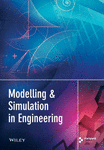Design of Interdisciplinary Operation Mechanism in Universities Considering Management Policy Constraints: A Multiagent Simulation Model
Abstract
Innovation is an important guarantee for maintaining national competitiveness and promoting social productivity, and it has a strong driving force for national and social development. At present, interdisciplinary research is widely used as a mechanism for innovation to solve complex problems, and universities are important subjects of innovation activities. Therefore, how to design the interdisciplinary operation mechanism in universities is of great significance to improving innovation productivity. This paper focuses on the design of interdisciplinary research management policies. By using a multiagent simulation model describing the university interdisciplinary research process, the useful management policies are determined by comparing the evolution results of the interdisciplinary research process under different management policy constraints. The simulation results show that (1) scientific research output and cooperation in interdisciplinary research of universities can be promoted by dynamic allocation policies, (2) interdisciplinary research performance can be increased by setting a proper number of research directions in universities, (3) the presence of teachers with high efficiency coefficient and high initial scientific research output will not negatively affect scientific research output and fairness of interdisciplinary research, and (4) high-level research output can be increased by setting proper rewards for high-level tasks in interdisciplinary research. The work of this paper can provide a basis for interdisciplinary research management policy design from a new theoretical perspective.
1. Introduction
Innovation is the driving force for economic development and improving national competitiveness. The essence of innovation is to raise and solve scientific problems by understanding the world. However, as the complexity of scientific problems increases, it is often difficult to solve complex scientific problems using knowledge in a single field, and collaborative use of multidisciplinary knowledge has become a necessary means to solve scientific problems and innovation. Interdisciplinary research, the concept of which was proposed in the 1920s and defined by the National Academy of Sciences [1] and Angelstam et al. [2] in recent time, is the new scientific research paradigm including breaking through disciplinary boundaries; sharing and integrating theories, methods, and knowledge from multiple disciplines; and solving scientific problem through interdisciplinary cooperation. Reference [3] also proposes the theoretical definition of interdisciplinary research based on the systematic review of related literature. Interdisciplinary research has become the most important means of innovation. As the important intersection of the resource of talent and the productive force of science and technology, universities shoulder the important mission of making original breakthroughs in basic research and cutting-edge technologies, enhancing the country’s original innovation capabilities, and serving the country’s economic and social development. Carrying out interdisciplinary research activities within universities is an effective way to promote the scientific research productivity of universities. Therefore, the design of efficient interdisciplinary research operating mechanism in universities is a very valuable topic that can affect innovation capabilities of universities and the country.
Many research results on interdisciplinary research operating mechanism have been proposed. Through analysis and review of interdisciplinary literatures, seven important attributes are identified to evaluate the efficiency of the research team [4]. Reference [5] investigates the operation mechanism of team learning in interdisciplinary research team including the antecedents and consequences to increase the team coordination efficiency. Rymmin and Lamberg [6] use multilevel boundary crossing as the theoretical framework to explain the multilevel nature of team learning mechanisms in interdisciplinary research. Based on an analysis on samples from 314 research teams in Chinese universities, Chen and Wang [7] studied the relationship between interdisciplinary research operation behaviors and research productivity. Feng and Kirkley [8] explore the link between interdisciplinary research collaboration and disciplinary diversity among collaborators and conclude that diverse research experiences of individual researchers mainly cause disciplinary diversity. Leahey and Barringer [9] studied the method to increase interdisciplinary research in universities and found that it is important to develop and reorganize academic units, as well as value commitments are fulfilled. Reference [10] indicates that in interdisciplinary research, there are three levels of integration of component, and four frameworks including common group learning, modeling, negotiation among experts, and integration by the project leader are given. For complex interdisciplinary projects, Konig et al. [11] introduce the Competing Values Framework into research management to acquire better structured planning and evaluation of coordination management. Tobi and Kampen [12] present a methodology framework of interdisciplinary research to support different sizes of cross-cutting issues between nature sciences and social sciences by designing research process and combinations of methods. By studying from research experiences and literature, a series of strategies are listed in [13] to help researchers to create integration across fields successfully. To facilitate interdisciplinary cooperation in the artificial intelligence (AI) research field, Bisconti et al. [14] propose methodologies including ethics-by-design and value-sensitive design to build the behavioral theory that describes the interaction process of interdisciplinary groups.
Simulation [15] is an important method of management mechanism research. Multiagent simulation is a bottom-up simulation method [16] that can present the complex, nonlinear organizational behavior, emergence, and evolution phenomena of the system through building models of individual attributes and behaviors of elements, as well as interaction behaviors between elements in the system. This method is suitable for the evolution analysis and prediction of multiparty interaction situations, and it has been applied to traffic prediction [17], combat simulation [18], epidemic prevention [19, 20], and many other fields. Currently, AI technologies such as reinforcement learning have also been introduced into multiagent simulation to simulate the learning and decision-making capabilities of agents [21–23]. Interdisciplinary research is a knowledge production behavior driven by multiparty collaboration. Its process involves complex conditions, individual decisions, and interactive behaviors. Therefore, knowledge innovation can be regarded as a complex system behavior involving the participation of multiple parties, and its evolution process can be described by multiagent simulation. Then, the interdisciplinary research operating mechanism can be designed based on the simulation results. In [24], the development process of small and medium enterprises is simulated using the multiagent method, and the link between performance improvement and innovation activity is studied. In [25], a multiagent model including the research team agent and the environment agent is built to simulate the interaction process and innovation activities of university research teams. In [26], based on the multiagent model which simulates the communication and decision-making behavior of users in the social network, the diffusion way of mobile application innovation is explored. Open and closed innovation strategies are compared under different market conditions using the multiagent simulation [27], and the results tell the applicable conditions of open innovation strategies. Aiming at the interdisciplinary research in innovation research, Kurz, Eder, and Heistracher [28] developed a multiagent simulation framework to simulate the evolution of interdisciplinary research ecosystems. In [29], possible negative phenomena in interdisciplinary research are studied through modeling boundary objects using the multiagent model.
As mentioned above, in the process of interdisciplinary research, participants promote evolution through decision-making behavior. The decision-making behavior of participants is essentially an optimization problem, and the decision is affected by the optimization goal and constraints. In interdisciplinary research in universities, management policies will determine the operation constraints, which in turn affects scientific research output. However, in existing research, there is a lack of research on interdisciplinary research management policy design. In addition, the maximization of total scientific research output is often used as the optimization goal, and the situation in which researchers use personal benefits as the optimization goal of decision-making has been ignored. Therefore, based on the collection of interdisciplinary research management policies in Chinese universities, this paper uses multiagent simulation to study the impact of different management policies on scientific research output, so as to design interdisciplinary research management policies.
The research in this paper is as follows: Section 2 describes and constructs the theoretical model and basic assumptions of interdisciplinary research of universities. Section 3 establishes the simulation model. Section 4 presents numerical simulation, that is, analysis of simulation results and strategy selection. Conclusion and revelation are in Section 5.
2. Theoretical Model and Basic Assumptions
2.1. Theoretical Model
The theoretical model of university interdisciplinary research is shown in Figure 1. The model includes two types of subjects: the university and teachers. The university provides an information-sharing platform to support interdisciplinary research cooperation negotiation between teachers. Universities can regulate the operation constraint interdisciplinary research process by formulating the management policies. The information-sharing platform and operation constraints constitute the operating environment of interdisciplinary research for individual teachers. Each teacher has his own attributes and generates research tasks based on his attributes. Teachers who generate research tasks use information-sharing platforms to consult with other teachers and establish research cooperations. When a research collaboration ends, scientific research output will be produced and the relevant attribute values of teachers involved in the cooperation will be updated.
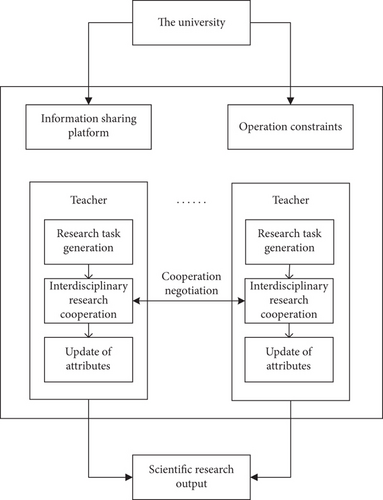
2.2. Basic Assumptions
2.2.1. Hypothesis 1
This hypothesis is about research tasks. Interdisciplinary research is carried out in units of research tasks. Research tasks are generated by teachers and can be transformed into scientific research output through interdisciplinary research coordination. Each research task contains several subtasks belonging to different scientific research directions and requires the interdisciplinary research cooperation of teachers from two different research directions to accomplished. Researchers will consume working time to complete research tasks. The working time required for task i is Ti,work. The working time required for subtask j of task i is Ti,j,work. The proportions of the working hours consumed by subtask j can be defined as ai,j = Ti,j,work/Ti,work. The scientific research output of research task i is represented by Pi. Pi,j, which is the scientific research output of subtask j in task i, can be calculated using Pi,j = Piri,j. ri,j is the reward ratio for subtask j of task i set by the university. We must note that Pi is determined by the assessment carried out by universities. Task level values are used to distinguish the importance of the scientific research output of tasks. The task level of research task i is denoted as Ki. Tasks with higher level values lead to higher scientific research output. Based on practical experience, we also assume that tasks with higher level values will consume more working hours. The total number of levels is denoted as Knum.
2.2.2. Hypothesis 2
This hypothesis is about teachers. The status of each teacher is indicated by the attribute values. The research direction of teacher s is os, and teacher s can only complete the research subtasks in direction os. Each teacher has a limited number of available working hours that is denoted as Ts,available. The total amount of scientific research output obtained by teacher s through completing subtasks is ACs. The attribute to reflect the attractiveness of teacher s in research cooperation is denoted as ARs. Considering practical experience, we assume that the teacher with higher ACs and more research collaboration experience will have a higher value of ARs. Teachers can improve work efficiency by establishing scientific research teams, such as recruiting graduate students. is defined as the efficiency coefficient of teacher s. The teacher s with can finish the task whose working time is Ti,j,work using time of . can be calculated using . Teachers can independently generate scientific research tasks and complete their tasks through research cooperation with teachers from other research directions. Teacher s records all the collaborators in his interdisciplinary research cooperations in lists. After each scientific research collaboration, teachers will update their attribute values. Teachers carry out the research activities including research task generation and interdisciplinary research cooperation according to individual status.
2.2.3. Hypothesis 3
This hypothesis is about universities. The interdisciplinary research process is carried out within one university. The university is composed of teachers belonging to multiple research directions. The number of research directions in the university is Nresearch. The research performance value of the university is the sum of ACs values of all teachers. Universities can implement management policies to influence the interdisciplinary research process.
- 1.
The methods for allocating scientific research output to participants of the interdisciplinary research. Allocation methods can be divided into static allocation and dynamic allocation. In static allocation, ri,j is fixed, and in dynamic allocations, ri,j can be decided by the initiator and participant of the task.
- 2.
Universities can control Nresearch through controlling the process of recruiting teachers.
- 3.
Universities can increase of teachers through encouraging teachers to expand their team size. For example, the teachers can increase the number of postgraduate students in their research teams.
- 4.
Universities can introduce research teams or teachers with high academic accumulation and high ACs.
- 5.
In most universities in China, higher Pi means that the teacher can get more rewards for completing the task. Universities can adjust Pi of tasks belonging to different levels, and Pi/Ti,work will also change accordingly. This may affect participants’ preferences in choosing research tasks.
3. Model Construction
In this section constructs, behavioral models of teachers are established.
3.1. Research Task Generation
ACaverage represents the average ACs value of teachers in the university, and it can be calculated with ACaverage = ∑t∈SACt/|S|. Here, S is the set of teachers, and |S| represents the total number of teachers. is the average research task generation probability. It indicates the task generation ability of teachers with average ACs, and its value can be decided based on the questionnaire. a1 and a2 are control coefficients which should be decided based on consultation with experts. Equation (1) shows that teachers whose ACs is higher than ACaverage can generate research tasks with a probability in the interval of , and teachers whose ACs is lower than ACaverage can generate research tasks with a probability in the interval of . To reflect the randomness of the task generation process, the random task generation probability is defined as .
3.2. Research Cooperation
Interdisciplinary research cooperation involves two steps. The first step is the cooperation negotiation between the research initiator and participants on whether to establish the research cooperation. The second step is the research implementation process in which research collaborators consume working hours and obtain scientific research output according to the task that they undertake. In this section, we mainly focus on cooperation negotiation.
In the cooperation negotiation, there are three substeps as follows.
First, research task initiators announce their tasks on the information-sharing platform.
- 1.
Tasks in the candidate research task list are re-sorted in descending order according to the values of of each task. indicates that scientific research output participant s can obtain from research task i in every working hour, and it implies the research efficiency of participant s in research task i.
- 2.
Filter items in the candidate research task list in order. The first task i which meets the condition of is chosen as the target task of candidate s and applied for cooperation to its initiator. Then, the target task chosen is removed from the candidate research task list, and Ts,available of participant s is updated according to .
- 3.
The filtering lasts multiple rounds until there is no task meeting the condition of in the candidate research task list.
- 4.
Participant s can select multiple tasks in one selection process.
Finally, initiator of task i establishes a candidate participant list based on the applications of cooperation received. The initiator chooses the candidate with the highest ARs as the collaborator in task i.
3.3. Update of Attributes
After the scientific research task is completed, the attributes of collaborators of the task including ACs value, lists, ARs value, and other attributes should be updated.
For teacher s, ACs can be updated as ACs = ACs + Pi,j. Pi,j is the scientific research output of subtask j completed by teacher s.
The name of the collaborators with teacher s in the cooperation is added to lists.
4. Numerical Analysis
In this article, multiagent simulation is built based on mesa that is an agent-based modeling framework in Python. Number of teacher agent is 100. The simulation lasts for 4000 time slots. The initial lists of each teacher is empty. The initial ACs value of each teacher is a random value generated according to uniform distribution U(1, 100). Ts,available is set to 30. The simulation consists of multiple rounds. There are four time slots in one round. In each round, multiple research tasks are proposed and implemented through the cooperation of teachers. Each teacher can propose at most one research task in one round and can participate in multiple tasks. To simplify the problem, in this simulation, each research task contains two subtasks. ai,1 of Subtask 1 of task i is a random value between zero and one generated by the task initiator, and ai,2 = 1 − ai,1. At the end of each round, all attributes of teachers are updated. The average value of the results of the 10 time simulations is used as the simulation result.
4.1. Parameter and Research Task Settings
4.1.1. Questionnaire Design and Data
In this paper, the questionnaire survey is adopted to determine several simulation parameters and design of research tasks. The parameters to determine include , a1, a2, α1, α2, and σ. Research task design needs to determine Knum. When the value of Knum is determined, Pi and Ti,work of tasks of each level also need to be set. In the questionnaire, definition and candidate values of each parameter are given, and the experts are required to give parameter value suggestions and reasons.
In the questionnaire survey designed with reference to [30], 50 experts from three universities in Shenyang City of China were invited to consult through social relations. Experts include teachers from various fields and staff from the research management department. In the questionnaire, male accounted for 58% and female accounted for 42%. Seventy percent of the experts had doctoral degree, and 30% of the experts had master’s degree. In terms of working years, 16% have worked for 5 years or less, 32% have worked for 5 years to 10 years, and 60% have worked for 10 years or more.
4.1.2. Analysis of Questionnaire Results
The simulation parameters were set according to the recommendations from most experts in the questionnaire survey. According to the research experience of most experts, , a1, and a2 should be 0.4, π/200 and π/400, respectively. Most experts suggest that, in ARs calculation, ACs and research cooperation experience of the teacher should be considered of equal importance, and both α1 and α2 should be set to 0.5. According to the opinions of most experts, σ was set to 0.05 to limit the deviation of from .
Considering practical experience, most experts suggest that Knum can be set to four. The scientific research output of tasks of Levels 1, 2, 3, and 4 should be 20, 50, 100, and 200, respectively. To reflect the randomness of Ti,work, Ti,work of tasks of Levels 1, 2, 3, and 4 is recommended to be a random value generated according to normal distribution N(Ts,available/3, v), N(Ts,available/2, v), N(Ts,available, v), and N(Ts,available, v), respectively. This setting method is consistent with the assumption that tasks with higher level values will consume more working hours. Here, the variance of the normal distribution is set to five according to the choice of most experts.
In addition, in this simulation, Ki of task i is related to of task i, and Ki can be decided as Ki = 1 if , Ki = 2 if , Ki = 3 if , and Ki = 4 if . This setup method implies that teachers with higher ACs are more likely to generate high-level tasks.
4.2. Simulation Analysis
4.2.1. Impact of the Methods for Allocating Scientific Research Output
In this section, the impact of the methods for allocating scientific research output on the total research performance value of the university is studied. Under the static allocation method, ri,1 and ri,1 are set to 0.7 and 0.3, according to the allocation policies implemented in the universities that we surveyed. Under the dynamic allocation method, ri,1 and ri,1 are set according to ai,1 and ai,2, which are dynamically determined by research task initiators.
It can be seen from Figures 2 and 3 that the total research performance value and the total number of research collaborations under the dynamic allocation method with a dynamic distribution ratio are both higher than those under the static allocation method with a fixed distribution ratio. The reason is that the dynamic method guarantees fairness of research cooperation, with avoiding reducing motivation of research cooperation due to unreasonable distribution of performance value. The result tells that the dynamic allocation method should be adopted in universities.
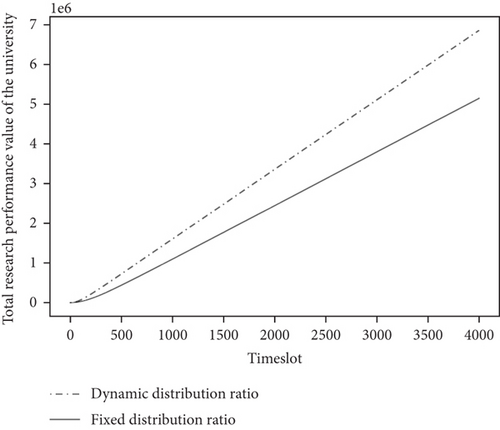
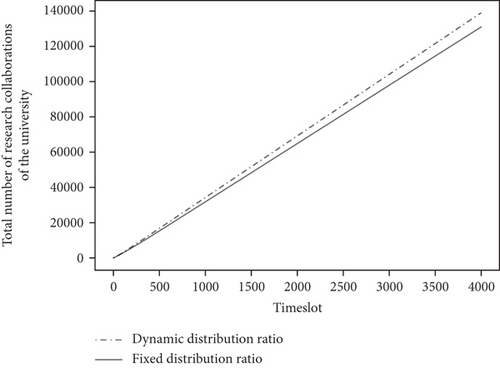
4.2.2. Impact of Number of Research Directions in Universities
In this section, a number of research directions are set to 8, 20, and 50, respectively.
As shown in Figures 4 and 5, the total scientific research performance value and the total number of scientific research collaborations are highest when there are 20 research directions. These values are second highest with 50 research directions, and the value is the lowest when the number of research directions is eight. The reason is that the increase in the number of research directions can reduce the competition among teachers and promote the possibility of scientific research cooperation to increase both the number of research tasks and total research achievements. However, if the number of research directions increases to be close to the number of teachers, teachers can not make full use of their available working hours, resulting in a decrease in the number of research collaborations and total research performance value. The simulation results tell that in a university, the number of research directions should be adjusted according to the number of teachers, in order to fully establish research cooperation among teachers.
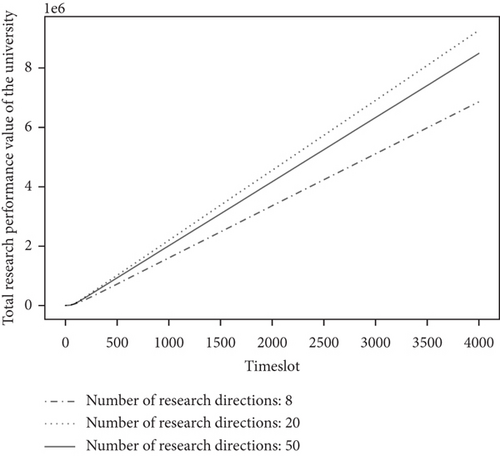
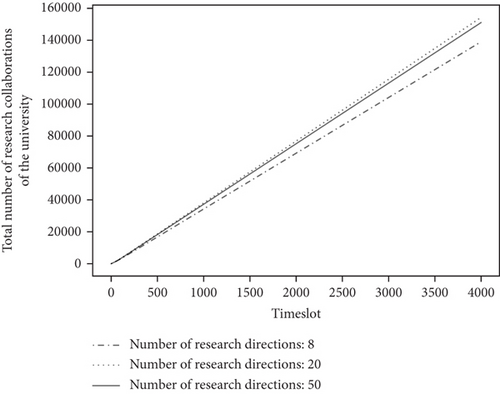
4.2.3. Impact of Research Teams With High Efficiency Coefficient
Teachers can improve their research implementation ability through establishing research teams including graduate students, and their efficiency coefficient value will increase. In this section, the impact of research teams with high efficiency coefficients will be studied. In the simulation, it is assumed that in the university, there is a certain percentage of teachers with a high efficiency coefficient. Results under 12 different conditions are compared. The efficiency coefficient value of teams, , is set to 1, 2, 3 and 4, respectively, and the percentage is set to 10%, 20%, and 30%, respectively. means that the efficiency coefficient values of all teachers are equal. For the convenience of drawing, is written as Wim in the figures.
It can be seen from Figure 6 that after 500 time slots of simulation, the presence of teams with high efficiency coefficient does not promote the total research performance value of the university, and after 4000 time slots of simulation, the total research performance value in the conditions of is slightly higher than that in the condition of . However, there are only little differences in total research performance value between conditions of different and percentage of teachers with high efficiency coefficient. As seen in Figure 7, if teams with high efficiency coefficient exist, the Gini coefficient of research performance value in the university increases. However, as the simulation continues from time slots 500 to 4000, Gini coefficient declines by about 25%.
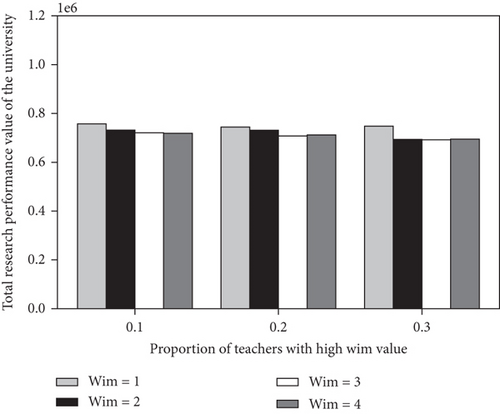
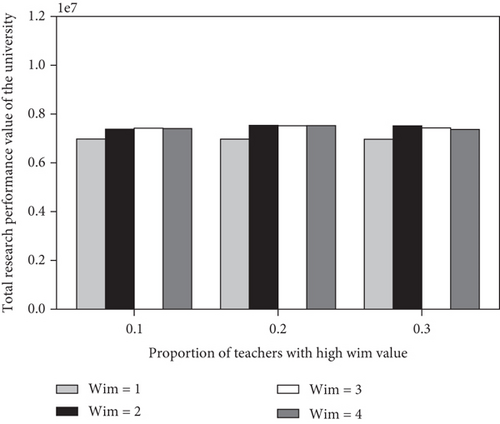
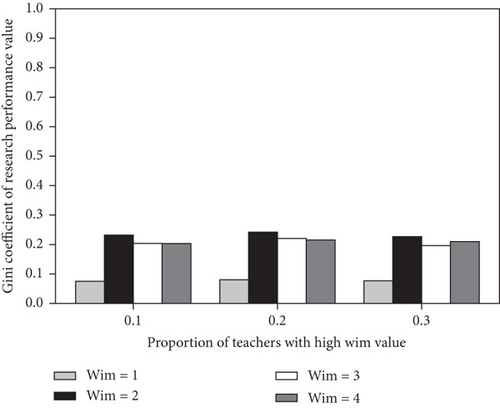
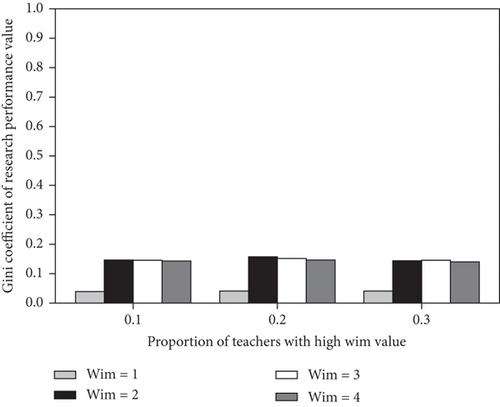
From the simulation results, the fact can be obtained that with the establishment of teams with higher efficiency coefficient, there is an increase in total research performance value and there is not a great negative impact on fairness of research output. The reason is that, although teams with higher efficiency coefficient value can obtain more opportunities of applications of research cooperation, task initiators select participants mainly according to ARs value of teachers, which restricts teams with higher efficiency coefficient from obtaining more research collaborations. Therefore, teachers should be encouraged to improve research implementation ability in their research direction as well as strengthen interdisciplinary research cooperation with others.
4.2.4. Impact of the Initial Scientific Research Output
Sometimes, universities can introduce teachers with good research experience. The ACs of these new teachers are high. In this section, the impact on research cooperation in the university of teachers with high initial scientific research output will be studied. In the simulation, it is assumed that in the university, there is a certain percentage of teachers with high initial scientific research output, which is denoted by AC in this section. Results under 12 different conditions are compared. The initial AC value of teachers with high initial scientific research output is set to 0, 1000, 2000, and 4000, respectively, and the percentage is set to 10%, 20%, and 30%, respectively. Initial AC being zero means that all teachers have no research collaboration history in the university.
It can be seen from Figure 8 that after 500 time slots of simulation, the presence of teams with high initial scientific research output can promote total research performance value of the university, and the higher the initial scientific research output and the percentage is, the more obvious the promotion effect is. However, after 4000 time slots of simulation, the promotion effect disappears. Figure 9 shows that, under the conditions of teachers with high initial scientific research output exist, the Gini coefficient of research performance value in the university increases. However, as the simulation continues from time slots 500 to 4000, the value of Gini coefficient declines below 0.15, and the result means that the research output distribution of teachers is average.
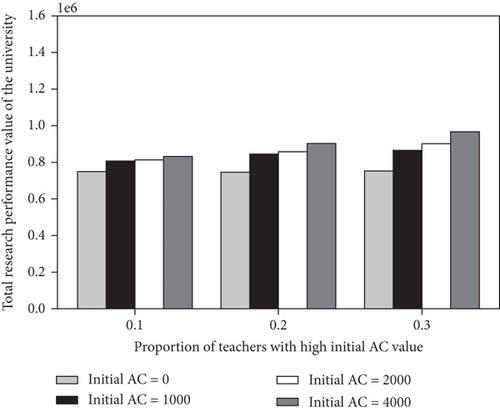
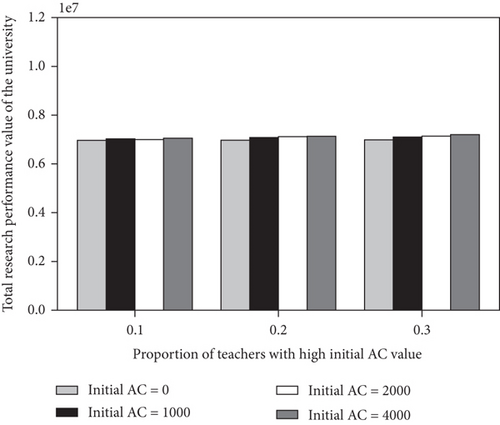
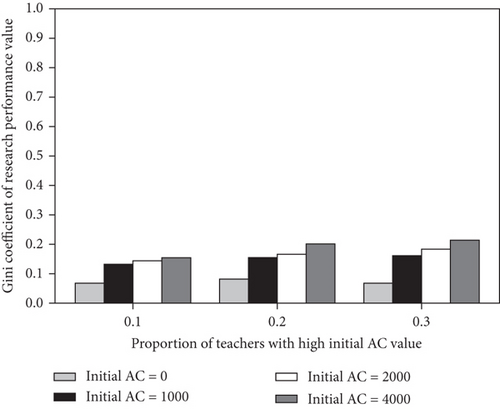
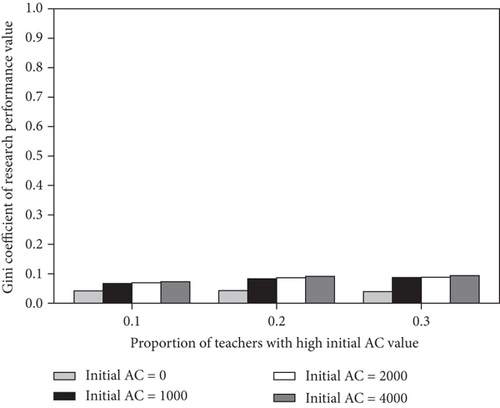
From the simulation results, the fact can be obtained that teachers with high initial scientific research output will not cause a negative impact on total research performance value and fairness of research output in universities. The reason is that available working hours of teachers with high initial scientific research output are limited.
4.2.5. Impact of Assigning High Pi Value to High-Level Research Tasks
In this section, we want to study the impact of assigning high Pi value to high-level research tasks on the increase of scientific research output of high-level tasks. Pi/Ti,work is an indicator which reflects the unit time benefits of research tasks, and Pi/Ti,work can be adjusted through adjusting Pi. Pi/Ti,work can be transformed into which is the basis for teachers to decide whether to participate in the research tasks. In this simulation, Pi/Ti,work of [Tasklevel1, Tasklevel2, Tasklevel3, Tasklevel4], which are denoted as P/T, are set to [2,10/3,10/3,10/3], [2,10/3,10/3,20/3], and [2,10/3,10/3,50/3], respectively.
As can be seen from Figure 10, when P/T = [2, 10/3, 10/3, 10/3], only tasks of Level 1 are completed. The reason is that Pi/Ti,work of tasks of high level is low, and teachers dedicate in applications of tasks of Level 1 to obtain higher research performance value. When Pi/Ti,work of tasks of Level 4 is increased, the outputs of tasks of Level 4 are significantly promoted. However, when Pi/Ti,work of tasks of Level 4 is set to 20/3 and 50/3, there is no significant difference in outputs of tasks of high level.
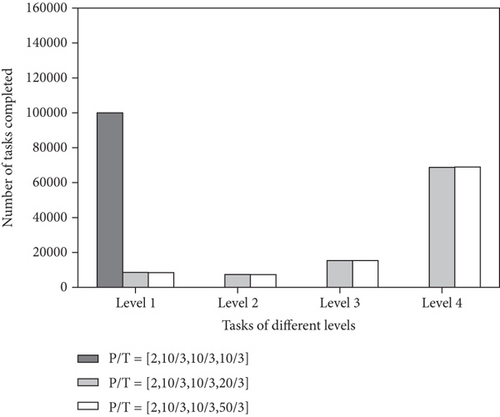
The result tells that research management department of universities should set Pi of tasks based on the practical working hours consumed. If the Pi/Ti,work of tasks of high level is too low, teachers will tend to low level research tasks. If Pi/Ti,work of tasks of high level is too high, the promotion effect on outputs of high level research is not obvious and bonuses related to research performance value will be wasted.
5. Conclusions and Enlightenment
5.1. Conclusions
Innovation is an important driving force for national economic and social progress. Considering that universities are an important part of the national innovation system and interdisciplinary research is an important innovative approach to complex problems today, the research topic of how to design interdisciplinary research operating mechanism in universities is of great significance to promote innovation. Therefore, in this paper, we study how to design management policies to influence interdisciplinary research processes and improve scientific research output in universities. The multiagent model is constructed to describe interdisciplinary research processes in universities. The evolutionary results under different management policies are compared and analyzed to choose effective management policies. Based on the simulation results, the following conclusion can be obtained. (1) Dynamic allocation policies can increase scientific research output and cooperation in interdisciplinary research of universities. (2) Setting a proper number of research directions in universities is a useful way to promote interdisciplinary research performance. (3) The presence of teachers with high efficiency coefficients does not negatively affect the performance and fairness of interdisciplinary research. (4) The presence of teachers with high initial scientific research output also does not negatively affect the performance and fairness of interdisciplinary research. (5) Setting proper rewards for high-level tasks can increase high-level research output.
5.2. Theoretical Contribution
The theoretical contribution of this paper includes that we construct a new multiagent simulation model for interdisciplinary research in universities, which introduces management policies and self-interested decision-making rule of teachers into the evolutionary process. This work provides a new theoretical perspective to study interdisciplinary research operating mechanism design.
5.3. Practical Enlightenment
Through the research in this paper, we can obtain the following enlightenments. (1) Universities should give participants of research tasks the power to freely allocate research outputs, in order to fully promote scientific research cooperation in interdisciplinary research. (2) Universities should ensure that the ratio of the number of teachers to the number of research directions is appropriate to fully develop research cooperation. (3) While encouraging teachers to expand their research teams, universities should also help them increase opportunities for research cooperation and enable them to make full use of research human resources. (4) Universities should help teachers with high initial scientific research output to expand their teams to enable teachers to increase the number of collaborations that they can support. (5) Excessive rewards can not promote the production of high-level research output. When universities set up reward policies for high-level research results, universities should pay attention to setting appropriate reward levels to prevent waste.
5.4. Deficiencies and Future Research Directions
In this paper, interdisciplinary research in a single university is studied. In actual situations, an interdisciplinary research collaboration between multiple universities and research institutions is also common, and we will take it as the future research topic.
Conflicts of Interest
The author declare no conflicts of interest.
Funding
The research work of this paper is funded by the Liaoning Provincial Social Science Planning Fund Project with number L21BTQ007.
Acknowledgments
Gratitude is extended to anonymous reviewers whose valuable feedback contributed to enhancing the quality of this work.
Open Research
Data Availability Statement
Please contact the author if the data is needed.



